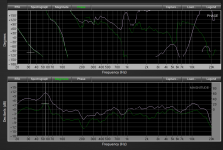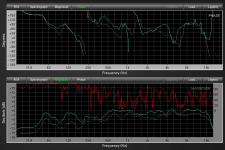Bob,I performed another test last night, in a smaller room (10x13 ft) using BR enclosed Fe-103's. There was just under 3 db increase going from 1 - 2 speakers, and an additional 2 db from moving them together.
There appears to be a pattern of test results, with open air tests (4 pi space) yielding a 6 db increase, while tests performed in listening rooms (folded 2 pi space?) only yield a 3 db increase. These results may indicate that the testing (acoustical) environment is itself an important (perhaps critical) factor.
"In room results will of course vary, but in a “perfect” room, with “perfect” speakers, the test verifies that a 6 dB increase from one to two equally powered speakers should be seen across the entire audio range."
Bob
I'd agree with your assessment "Perhaps the only perfect room is no room"
Testing my home stereo indoors results in about a 3 dB gain (as measured with a dB meter) from one to two speakers, the same as one would expect in the difference between coherent (+6 dB) and incoherent noise (+3 dB) summation.
The graphs show that in the LF, where the phase aligns fairly well between one and two speakers, the gain is a bit more than 3 dB.
With the mono sub engaged, the level increases 6dB in the sub range when both left and right inputs are combined.
Small movements in the microphone result in large magnitude and phase differences, IIRC the "nosub" mic placement was more centered between L/R, the screen shot with the sub was my normal "couch potato" listening position which is a foot or so to the right of center.
At any rate, when considering the increase from one to two "full range" speakers, one should probably not count on more than 3 dB, and choose power and sensitivity accordingly.
Art
Attachments
Art,
I think that sums it up pretty well:
“when considering the increase from one to two "full range" speakers, one should probably not count on more than 3 dB, and choose power and sensitivity accordingly.”
Regarding the original topic, if music is reproduced at what one considers normal spls, and there is no audible degradation during musical peaks, and there is no clipping visible on an oscilloscope (and especially if the peaks occur well below clipping level as seen on the scope), then one has adequate power.
The required power will vary from person to person, as some are enjoy playback at levels well below live spls, while other seek to duplicate or even exceed live levels. To each there own.
The reproduction of rogue peaks 15 to 30 db or more above average levels will be a concern for some, but not for everyone. These are rarely accurately recorded on commercial recordings. Again, this is easily checked on an oscilloscope, by simply watching the waveform while listening to ones favorite music at normal listening spls (whatever they may be).
For those who do not have access to an oscilloscope, the use of an spl meter (adequate models are available for $30 - $50) will allow comparison to what others have reported.
Regards,
Bob
I think that sums it up pretty well:
“when considering the increase from one to two "full range" speakers, one should probably not count on more than 3 dB, and choose power and sensitivity accordingly.”
Regarding the original topic, if music is reproduced at what one considers normal spls, and there is no audible degradation during musical peaks, and there is no clipping visible on an oscilloscope (and especially if the peaks occur well below clipping level as seen on the scope), then one has adequate power.
The required power will vary from person to person, as some are enjoy playback at levels well below live spls, while other seek to duplicate or even exceed live levels. To each there own.
The reproduction of rogue peaks 15 to 30 db or more above average levels will be a concern for some, but not for everyone. These are rarely accurately recorded on commercial recordings. Again, this is easily checked on an oscilloscope, by simply watching the waveform while listening to ones favorite music at normal listening spls (whatever they may be).
For those who do not have access to an oscilloscope, the use of an spl meter (adequate models are available for $30 - $50) will allow comparison to what others have reported.
Regards,
Bob
- Status
- This old topic is closed. If you want to reopen this topic, contact a moderator using the "Report Post" button.

